
Myopia is a global health concern due to its increasing prevalence. According to the World Health Organization, almost 30% of the world's population is affected by myopia. This percentage is expected to rise in the coming years, highlighting the significance of understanding this condition.
The Age Group Most Affected by Myopia
Although myopia can affect individuals of any age, it is most common among specific age groups. The age at which myopia typically begins is during school-age years, between six and fourteen. During this period, children undergo significant physical growth and development, including their eyes. As such, this is a crucial time for the onset of myopia.
The Importance of Regular Eye Exams for Early Detection of Myopia
Early detection of myopia is crucial in managing the condition effectively. Regular eye exams play a significant role in this regard. These exams not only help identify myopia at an early stage but also track its progression and determine the most effective management strategies.
Eye exams are especially important for school-age children and adolescents, the age groups most affected by myopia. Regular eye check-ups can ensure that any changes in their vision are detected and addressed promptly. This is particularly important as children may not always be able to articulate their vision problems.
For adults, regular eye exams are equally critical. Even if you had perfect vision during your younger years, the risk of developing myopia or other eye conditions increases with age. Regular eye exams can help identify these issues early, allowing for timely intervention and management.
Symptoms and Signs of Myopia
Myopia presents a range of symptoms and signs that can vary among individuals. The primary symptom is blurred distance vision. This often leads to squinting or closing the eyes to see distant objects more clearly.
Other common symptoms include headaches, eye strain, and fatigue, particularly after prolonged periods of near work. Difficulty seeing while driving, especially at night, is another common sign of myopia.
In children, myopia may manifest as poor academic performance, frequent eye rubbing, or excessive blinking. It's crucial for parents and teachers to watch out for these signs, as children may not always be aware of their vision problems or express them clearly.
Common Myopia Management Techniques
Managing myopia involves a combination of techniques, depending on the severity of the condition and the individual's lifestyle needs. The most common management techniques include glasses and contact lenses. These devices correct the refractive error, allowing for clearer distance vision.
In recent years, myopia control strategies have gained attention. These include orthokeratology, multifocal contact lenses, and atropine eye drops. These techniques aim not only to correct myopia but also to slow its progression, particularly in children and adolescents.
Lifestyle modifications can also help manage myopia. This includes limiting screen time, taking regular breaks during near work, and spending more time outdoors. A balanced diet rich in essential nutrients also contributes to overall eye health and may help slow the progression of myopia.
Maintaining Eye Health
Myopia is a common eye condition that typically begins during the school-age years and adolescence. However, with early detection through regular eye exams and effective management strategies, it can be successfully managed.
It's important to remember that while myopia is most common in certain age groups, it can affect individuals of all ages. Therefore, maintaining good eye health should be a priority for everyone, regardless of age.
To learn more on myopia and effective management techniques, visit Beach Cities Optometry in our Manhattan Beach, California, office. We provide quality eye care services and products for the entire family. Call (424) 484-1100 to schedule an appointment today.







